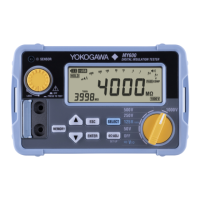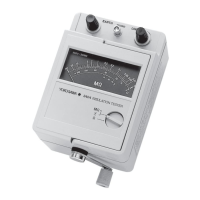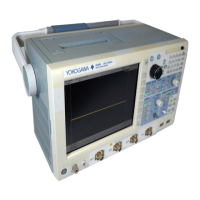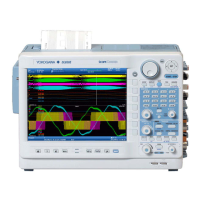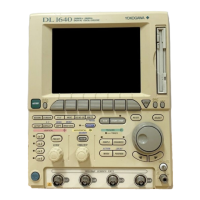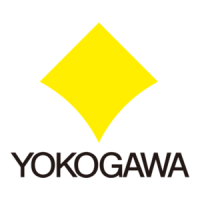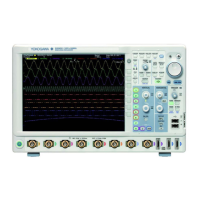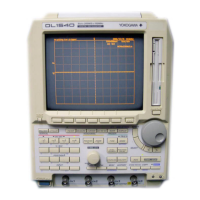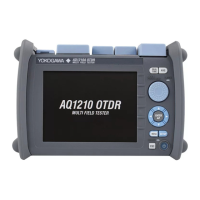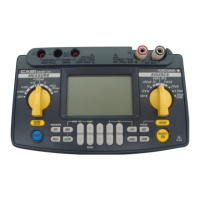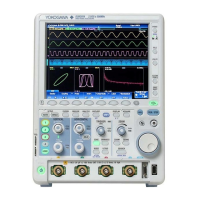Do you have a question about the YOKOGAWA ScopeCorder DL950 and is the answer not in the manual?
Explains how to select between Scope mode and Recorder mode for instrument operation.
Guides on resetting instrument settings to their factory default values.
Details on automatically configuring instrument settings for optimal input signal measurement.
Instructions for managing and configuring measurement applications registered in advance.
Settings for voltage measurements on modules other than 16-CH temperature/voltage input modules.
Settings for voltage measurements specific to 16-CH temperature/voltage input modules.
Settings for temperature measurements on modules other than 16-CH temperature/voltage input modules.
Settings for temperature measurements specific to 16-CH temperature/voltage input modules.
Settings for configuring strain measurements, including sensor and balancing.
Settings for acceleration measurements, including sensor sensitivity and bias current.
Settings for various electrical and mechanical measurements.
Settings for logic measurements, including logic bits and deskewing.
Settings for monitoring CAN and CAN FD bus signals, including frame reading.
Settings for monitoring LIN bus signals, including frame reading and symbol files.
Settings for monitoring SENT signals, including frame reading and error channels.
Provides a consolidated view and setup for all instrument channels.
Instructions for applying digital filters to signals for noise reduction.
Configures record length, acquisition mode, and trigger settings in Scope mode.
Configures recording time, sample interval, and acquisition method in Recorder mode.
Guides on initiating and terminating waveform data acquisition.
Explains how to use the dual capture feature for simultaneous low and high-speed sampling.
Details on setting up and performing continuous waveform recording to SSD.
Explains different trigger modes like Auto, Normal, Single, and their settings.
Adjusts trigger point location, delay time, and hold-off period for precise triggering.
Configuration for triggering based on signal edge characteristics in Scope mode.
Settings for triggering waveform acquisition based on specific date and time.
How to set up triggering using an external signal source.
Configuration for triggering based on logic signal edges and states.
Advanced triggering based on sequential state conditions (A to B over N occurrences).
Advanced triggering that occurs after a specified delay following condition A.
Advanced triggering that occurs when an edge event happens during state A.
Combines multiple trigger conditions using OR or AND logic in Scope mode.
Advanced triggering based on the period of a waveform event.
Advanced triggering based on the width of a pulse event.
Advanced triggering based on whether a waveform stays within a defined window.
Configuration for triggering based on signal edge characteristics in Recorder mode.
Settings for triggering waveform acquisition based on specific date and time in Recorder mode.
Combines trigger conditions using OR or AND logic in Recorder mode.
Initiates a trigger and starts waveform acquisition manually.
Configures display groups and the number of divided screens for waveform viewing.
Customizes waveform display layout, color mapping, and grouping of channels.
Adjusts grid display types and interpolation methods for waveform visualization.
Adjusts scale display, font size, screen background, and channel information.
Enables waveform accumulation for averaging multiple waveforms in Scope mode.
Features for capturing and clearing waveforms from the display.
Configures the display of X-Y waveforms, including trace selection and display range.
Adjusts display ratio, window layout, interpolation, and data points for X-Y display.
Utilizes cursors to measure parameters of X-Y waveforms.
Controls zooming of waveforms, adjusting zoom windows, position, and factor.
Controls zooming of waveforms, adjusting display ratio, window layout, and auto scroll.
Locates specific edge events within waveform data based on defined conditions.
Finds specific events within waveform data based on event number.
Identifies specific logic patterns within digital signal data.
Locates waveform data recorded at a specific date and time.
Shows previously saved waveforms from acquisition memory.
Filters and finds specific history waveforms based on zones or parameters.
Measures vertical values (Y-axis) at specific points using horizontal cursors.
Measures time values (X-axis) at specific points using vertical cursors.
Measures frequency and vertical values using marker cursors.
Measures reference angles and reference cursor positions for angular data.
Measures time and vertical values simultaneously using horizontal and vertical cursors.
Configures settings for automatic measurement of waveform parameters.
Applies continuous statistical analysis to waveform data.
Performs statistical processing on waveform data cycle by cycle.
Applies statistical processing to waveform data stored in history memory.
Configures FFT window display, ratio, layout, and linking.
Configures FFT computation range, window functions, spectrum types, and averaging.
Uses cursors to measure frequency and vertical values of FFT waveforms.
Defines mathematical expressions and sets computation ranges for math functions.
Adjusts the vertical scale and scaling mode for computed math waveforms.
Configures averaging settings for math waveforms, including simple, cyclic, and exponential.
Creates custom math functions using expressions, filters, and constants.
Sets judgment criteria using waveform zones for GO/NO-GO analysis.
Sets judgment criteria using measured waveform parameters for GO/NO-GO analysis.
Defines actions to be executed upon trigger events, such as saving or mail transmission.
Sets up real-time math channels, including expressions, scaling, and display.
Applies real-time math settings across all channels simultaneously.
Performs power analysis, configuring analysis modes and wiring systems.
Analyzes harmonic content of signals, setting analysis modes and display types.
Configures settings for printing screen images to a network printer.
Configures settings for printing screen images to a USB printer.
Saves screen captures to files in various formats and destinations.
Instructions for connecting SD memory cards and USB storage devices.
Information on handling the instrument's internal SSD storage.
Guides on formatting connected storage devices like SSD and SD cards.
Methods for saving acquired waveform data in various formats.
Saves current instrument settings to internal memory or storage devices.
Saves screen captures, snapshot data, and analysis results to files.
Loads previously saved waveform data (.WDF) into the instrument.
Loads previously saved instrument setup data (.SET) from storage.
Loads snapshot waveforms (.SNP) and symbol data (.SBL) into the instrument.
Manages files and folders, including creating, copying, moving, and deleting.
Instructions for physically connecting the instrument to a network via Ethernet or SFP+ ports.
Sets IP address, subnet mask, gateway, DNS, and DHCP for network connectivity.
Configures the instrument as an FTP server for PC access to files.
Sets up the instrument as a Web server to monitor the display on a PC.
Establishes connections to network drives for saving and loading data.
Sets up the instrument to send emails via an SMTP client.
Configures SNTP settings for synchronizing instrument date and time with a network server.
Sets up the instrument to print screen images to a network printer.
Selects the mode for synchronizing instrument time over a network (GPS, IRIG, IEEE1588).
Sets the instrument as a master unit in IEEE1588, configuring clock source and priority.
Instructions for installing SFP modules and connecting multiple DL950 units.
Sets up the main unit and sub units for synchronized operation.
Manages waveform acquisition across multiple connected units.
Saves and loads instrument settings to/from internal memory.
Guides on performing instrument calibration for accurate measurements.
Selects languages for instrument messages, menus, and USB keyboard input.
Adjusts LCD settings, including backlight, auto-off, and brightness.
Configures the instrument to function as a USB storage device for data transfer.
Sets power-on actions, logic, I/O terminals, sounds, and touch panel behavior.
Enables or disables panel keys to prevent unintended changes.
Explains how to select between Scope mode and Recorder mode for instrument operation.
Guides on resetting instrument settings to their factory default values.
Details on automatically configuring instrument settings for optimal input signal measurement.
Instructions for managing and configuring measurement applications registered in advance.
Settings for voltage measurements on modules other than 16-CH temperature/voltage input modules.
Settings for voltage measurements specific to 16-CH temperature/voltage input modules.
Settings for temperature measurements on modules other than 16-CH temperature/voltage input modules.
Settings for temperature measurements specific to 16-CH temperature/voltage input modules.
Settings for configuring strain measurements, including sensor and balancing.
Settings for acceleration measurements, including sensor sensitivity and bias current.
Settings for various electrical and mechanical measurements.
Settings for logic measurements, including logic bits and deskewing.
Settings for monitoring CAN and CAN FD bus signals, including frame reading.
Settings for monitoring LIN bus signals, including frame reading and symbol files.
Settings for monitoring SENT signals, including frame reading and error channels.
Provides a consolidated view and setup for all instrument channels.
Instructions for applying digital filters to signals for noise reduction.
Configures record length, acquisition mode, and trigger settings in Scope mode.
Configures recording time, sample interval, and acquisition method in Recorder mode.
Guides on initiating and terminating waveform data acquisition.
Explains how to use the dual capture feature for simultaneous low and high-speed sampling.
Details on setting up and performing continuous waveform recording to SSD.
Explains different trigger modes like Auto, Normal, Single, and their settings.
Adjusts trigger point location, delay time, and hold-off period for precise triggering.
Configuration for triggering based on signal edge characteristics in Scope mode.
Settings for triggering waveform acquisition based on specific date and time.
How to set up triggering using an external signal source.
Configuration for triggering based on logic signal edges and states.
Advanced triggering based on sequential state conditions (A to B over N occurrences).
Advanced triggering that occurs after a specified delay following condition A.
Advanced triggering that occurs when an edge event happens during state A.
Combines multiple trigger conditions using OR or AND logic in Scope mode.
Advanced triggering based on the period of a waveform event.
Advanced triggering based on the width of a pulse event.
Advanced triggering based on whether a waveform stays within a defined window.
Configuration for triggering based on signal edge characteristics in Recorder mode.
Settings for triggering waveform acquisition based on specific date and time in Recorder mode.
Combines trigger conditions using OR or AND logic in Recorder mode.
Initiates a trigger and starts waveform acquisition manually.
Configures display groups and the number of divided screens for waveform viewing.
Customizes waveform display layout, color mapping, and grouping of channels.
Adjusts grid display types and interpolation methods for waveform visualization.
Adjusts scale display, font size, screen background, and channel information.
Enables waveform accumulation for averaging multiple waveforms in Scope mode.
Features for capturing and clearing waveforms from the display.
Configures the display of X-Y waveforms, including trace selection and display range.
Adjusts display ratio, window layout, interpolation, and data points for X-Y display.
Utilizes cursors to measure parameters of X-Y waveforms.
Controls zooming of waveforms, adjusting zoom windows, position, and factor.
Controls zooming of waveforms, adjusting display ratio, window layout, and auto scroll.
Locates specific edge events within waveform data based on defined conditions.
Finds specific events within waveform data based on event number.
Identifies specific logic patterns within digital signal data.
Locates waveform data recorded at a specific date and time.
Shows previously saved waveforms from acquisition memory.
Filters and finds specific history waveforms based on zones or parameters.
Measures vertical values (Y-axis) at specific points using horizontal cursors.
Measures time values (X-axis) at specific points using vertical cursors.
Measures frequency and vertical values using marker cursors.
Measures reference angles and reference cursor positions for angular data.
Measures time and vertical values simultaneously using horizontal and vertical cursors.
Configures settings for automatic measurement of waveform parameters.
Applies continuous statistical analysis to waveform data.
Performs statistical processing on waveform data cycle by cycle.
Applies statistical processing to waveform data stored in history memory.
Configures FFT window display, ratio, layout, and linking.
Configures FFT computation range, window functions, spectrum types, and averaging.
Uses cursors to measure frequency and vertical values of FFT waveforms.
Defines mathematical expressions and sets computation ranges for math functions.
Adjusts the vertical scale and scaling mode for computed math waveforms.
Configures averaging settings for math waveforms, including simple, cyclic, and exponential.
Creates custom math functions using expressions, filters, and constants.
Sets judgment criteria using waveform zones for GO/NO-GO analysis.
Sets judgment criteria using measured waveform parameters for GO/NO-GO analysis.
Defines actions to be executed upon trigger events, such as saving or mail transmission.
Sets up real-time math channels, including expressions, scaling, and display.
Applies real-time math settings across all channels simultaneously.
Performs power analysis, configuring analysis modes and wiring systems.
Analyzes harmonic content of signals, setting analysis modes and display types.
Configures settings for printing screen images to a network printer.
Configures settings for printing screen images to a USB printer.
Saves screen captures to files in various formats and destinations.
Instructions for connecting SD memory cards and USB storage devices.
Information on handling the instrument's internal SSD storage.
Guides on formatting connected storage devices like SSD and SD cards.
Methods for saving acquired waveform data in various formats.
Saves current instrument settings to internal memory or storage devices.
Saves screen captures, snapshot data, and analysis results to files.
Loads previously saved waveform data (.WDF) into the instrument.
Loads previously saved instrument setup data (.SET) from storage.
Loads snapshot waveforms (.SNP) and symbol data (.SBL) into the instrument.
Manages files and folders, including creating, copying, moving, and deleting.
Instructions for physically connecting the instrument to a network via Ethernet or SFP+ ports.
Sets IP address, subnet mask, gateway, DNS, and DHCP for network connectivity.
Configures the instrument as an FTP server for PC access to files.
Sets up the instrument as a Web server to monitor the display on a PC.
Establishes connections to network drives for saving and loading data.
Sets up the instrument to send emails via an SMTP client.
Configures SNTP settings for synchronizing instrument date and time with a network server.
Sets up the instrument to print screen images to a network printer.
Selects the mode for synchronizing instrument time over a network (GPS, IRIG, IEEE1588).
Sets the instrument as a master unit in IEEE1588, configuring clock source and priority.
Instructions for installing SFP modules and connecting multiple DL950 units.
Sets up the main unit and sub units for synchronized operation.
Manages waveform acquisition across multiple connected units.
Saves and loads instrument settings to/from internal memory.
Guides on performing instrument calibration for accurate measurements.
Selects languages for instrument messages, menus, and USB keyboard input.
Adjusts LCD settings, including backlight, auto-off, and brightness.
Configures the instrument to function as a USB storage device for data transfer.
Sets power-on actions, logic, I/O terminals, sounds, and touch panel behavior.
Enables or disables panel keys to prevent unintended changes.
| Brand | YOKOGAWA |
|---|---|
| Model | ScopeCorder DL950 |
| Category | Test Equipment |
| Language | English |

